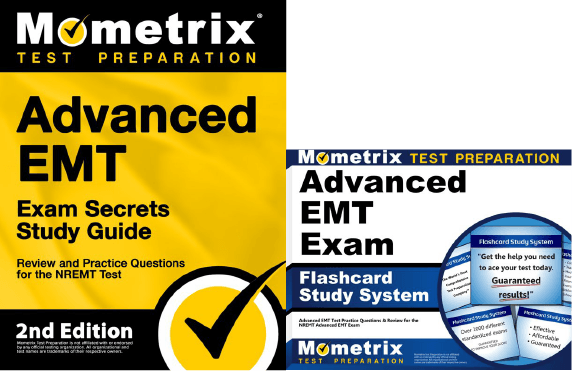If you need help studying for the Advanced Emergency Medical Technician (AEMT) exam or just want some more information about what the exam is like, you’ve come to the right place.
Click below to take a free Advanced EMT practice test!
AEMT Eligibility
Before you can begin the registration process, you’ll need to make sure you meet the necessary eligibility requirements:
- You need to hold an EMT license (or higher)
- You need to complete a state-approved AEMT course
- You need to have a current CPR-BLS for Healthcare Provider credential (or an equivalent)
Once you’ve met all of the above requirements, you can register for the exam!
What’s on the Exam?
First, let’s talk about the questions on the exam. There are 135 questions total, but only 100 of the questions will count toward your score. Why is that?
The 35 unscored questions on the exam are called “pilot” questions. These are added to the exam to determine if they’re good enough questions to add to future versions of the test.
The trick is that you won’t have any way of knowing which questions are scored and which ones are pilot. They will appear just like the scored questions throughout the test.
The time limit for the exam is 3 hours. There aren’t any scheduled breaks, but you’re free to take restroom breaks as needed.
Let’s take a closer look at each section of the exam.
AIRWAY, RESPIRATION, AND VENTILATION
9%-13% of the exam
- Evaluation of airway patency, breathing, and ventilation
- Techniques for assessing respiratory rate, rhythm, and effort
- Use of tools such as pulse oximetry and capnography
- Respiratory disorders
- Physiological effects of hypoxia and hypercapnia
- Mechanisms of airway obstruction and respiratory failure
- Airway management techniques
- Use of ventilation devices
- Administration of medications for airway and respiratory conditions
CARDIOLOGY AND RESUSCITATION
11%-15%
- Techniques for assessing cardiac function
- Identification of signs and symptoms of cardiac emergencies
- Use of diagnostic tools for cardiac assessment
- Cardiovascular diseases
- Mechanisms of cardiac arrhythmias and arrest
- Effects of systemic and pulmonary circulation disorders
- Cardiac arrest management protocols
- Use of defibrillation and cardioversion devices
- Pharmacological interventions for cardiac emergencies
TRAUMA
7%-11%
- Initial and secondary surveys in trauma situations
- Techniques for assessing severity of injuries
- Use of trauma scoring systems
- Traumatic injury mechanisms
- Physiological responses to trauma
- Impact of trauma on different body systems
- Trauma management protocols
- Techniques for hemorrhage control and splinting
- Administration of fluids and medications in trauma care
MEDICAL, OBSTETRICS, AND GYNECOLOGY
25%-19%
- Comprehensive assessment techniques for medical and obstetric conditions
- Identification of signs and symptoms in gynecological emergencies
- Use of diagnostic tools for medical assessment
- Common medical conditions
- Mechanisms of obstetric complications
- Effects of gynecological disorders on the body
- Management protocols for medical emergencies
- Obstetric emergency interventions
- Pharmacological and non-pharmacological treatments for gynecological conditions
EMS OPERATIONS
6%-10%
- Maintenance and operation of emergency equipment and vehicles
- Leadership and professionalism
- Communication
- Documentation
- Environment of care
- Preservation of medical and legal standards
CLINICAL JUDGMENT
31%-35%
- Communication and leadership
- Recognizing and analyzing cues
- Defining hypotheses
- Generating solutions
- Taking action
COMPUTER-ADAPTIVE TESTING (CAT)
The AEMT exam is a computer-adaptive test. Basically, this means that the questions will become harder or easier as you go through the exam, based on how well you’re answering the questions.
For example, say you answered the first question correctly. The first question is of medium difficulty, so the next question will be slightly harder. Then, let’s say you answered the second question incorrectly. The next question would then be a medium question.
How to Register
To get started with the registration process, you’ll need to create an account on the NREMT website. You can then submit an application through your account, which will include the $159 application fee.
When your application is approved, you’ll be able to print your Authorization to Test (ATT) letter. This will give you all the information you need to set up a testing appointment.
Exam Scores
The AEMT exam is scored using a scaled scoring method. Here’s how it works:
For every question you answer correctly, you get one point added to your raw score. At the end of the test, your final raw score will be converted to a scaled score. This scaled score will range somewhere between 100 and 1500.
You will need a score of at least 950 to pass the test.
The reason your raw score is converted to a scaled score is because everyone who takes the test is given a slightly different set of questions. Since everyone has a different arrangement of questions, and because some questions are harder than others, converting your raw score to a scaled score ensures a more even playing field.
Retaking the Exam
If you didn’t get a passing score on your first try, that’s okay! You can take the exam again after a 15-day waiting period.
Keep in mind that after six attempts, you’ll have to retake the entire EMT course from a state-approved program before you can register for another attempt.
FAQs
How many questions are on the AEMT exam?
There are 135 multiple-choice questions on the exam.
What is the time limit for the AEMT exam?
The exam is timed at 3 hours.
How much does the AEMT exam cost?
The application fee is $159.



 AEMT Study Guide
AEMT Study Guide AEMT Flashcards
AEMT Flashcards
